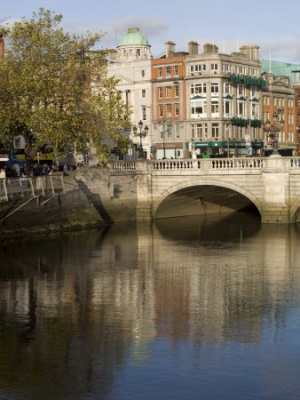Ireland's River Liffey
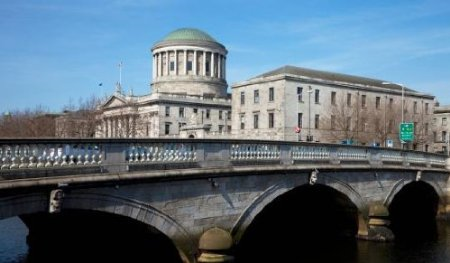 |
Ireland's River Liffey is the main river in Dublin, the capital of Ireland. It begins at Sally Gap near Kippure in County Wicklow, just south of Dublin. It travels about 78 miles through the center of Dublin and out into Dublin Bay, eventually reaching the Irish Sea. Down through the centuries the name of the River Liffey has taken many forms, which suggest Irish, English, French and Latin influences. In public records, deeds and maps, the absence of a single recognized spelling may have reflected the sounds that individual scribes heard. Abhann Liffe, Gaelic for River of Life, could have become in an Anglicized version Avon Liffey. The formal name is now Liffey.
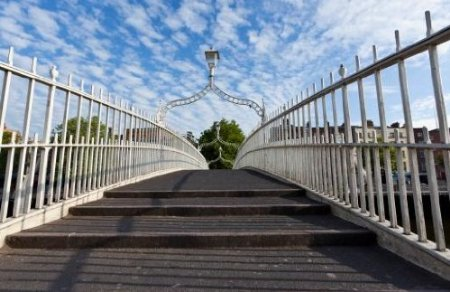 |
Starting with the Ha'Penny Bridge the following are some of the more well known of the 16 bridges spanning the Liffey. The Ha'Penny Bridge is a walk over bridge that crosses the River Liffey. It's official name is the Liffey Bridge, but to the people of Dublin it is Ha'Penny Bridge. It was built as a toll bridge in 1816 to replace the Bagnio Ferry. For a short time it was known as the Wellington Bridge, but the Duke didn't care for it, so the name was dropped. It was also known briefly as the Triangle Bridge. Now the bridge is called the Ha'Penny Bridge because they used to charge half a penny to cross it, but now it is free.
O'Connell Bridge is the probably the most famous one because of it's link to Irish Patriot Daniel O'Connell. This Bridge is in the city center and spans the Liffey between O'Connell Street to the north and O'Connell Street to the south. It is the second bridge to stand at this location. Following the development of new streets, a new and wider bridge was needed because of the increased traffic. In 1880 it had the distinction of being nearly as wide as was is long and the bridge was renamed in honor of Daniel O'Connell.
The Anna Livia Bridge was originally named Chapelizod Bridge. It was changed in 1982 and became the Anna Livia Bridge in honor of James Joyce. This famous Irish author wrote the novel "Finnegan's Wake", in which he called the river Anna Livia Plurabelle. This bridge was built on an ancient ford site of the old highway leading to the west of Ireland.
The Island Bridge is a single span masonry arch bridge. It crosses the Liffey between Conyngham Road to the north and South Circular Road to the south. Soon after it had been built, the bridge was known as Island Bridge because it was built near near an island in the River Liffey. Island Bridge is now it's official name, but it is sometimes called Kilmainham Bridge because of it's proximity to Kilmainham.
Butt Bridge spans the River Liffey between Beresford Place to the north and Tara Street to the south. It was the first bridge built on this site in 1879. It was built as a swivel bridge to allow ships to come further up the river. Following increased traffic, rebuilding and widening of the bridge was completed in 1932. Butt bridge is named in honor of Isaak Butt, who was the leader of the Irish Party in the House of Commons and founder of the Home Rule for Ireland Movement.
The Loop Line Railway Bridge connects Tara Street Station to the south of the River Liffey to Connolly Station to the north. This bridge is made of cast iron but it stands on a series of Grecian columns made of limestone. In the 1920s, the Dublin Corporation had researched the possibility of building a tunnel under the Liffey to carry the railway and abolish the Loop Line Bridge. It was decided that it was impractical.
The last bridge on the river is the East Link Bridge, a toll bridge, which is about 440 yards from the mouth of the Liffey. This bridge spans from Eastwall Road to the north and the Eastlink Road to the south, and replaced a ferry service which had operated since 1665. This bridge's construction was a huge engineering undertaking completed in 18 months and was opened in 1984.
There are many historic buildings along the banks of the River Liffey. Soyers Food Kitchen was built in the winter of 1847, during the Great Famine. The government invited Alexis Soyer who was probably the most famous chef in Europe at the time to help them. This soup kitchen was built at the front of the Royal Barracks in Dublin.
In 1791 the Custom House was built of granite and Portland stone, and cost about half million pounds. It was burned in 1921 but the exterior was mostly unharmed. In the back of the Custom House, four statues were erected to represent Europe, Asia, Africa, and America.
The Liffey quays, where ships loaded and unloaded cargo, were almost all built of stone. The stone parapets on the Liffey quays were built mostly at the end of the eighteenth and early nineteenth century. Sea going river traffic has been steadily pushed downstream over the last three hundred years. The last quay up river to be used was Victoria Quay, where the Guinness steam barges continued to operate until 1961.
In the 1780s, unknown sculptor Edward Smyth was hired by architect James Gandon to design fourteen river head stones. These were based on traditional motifs and incorporated principal features of the counties the river flowed through. The Civic Offices are Dublin Corporation. They were built a few years ago amid a lot of controversy. About fifty years after the Norsemen established their settlement in Dublin, they constructed an earthen bank to hold back the tide and to make space for loading and unloading their ships. This was the first wood quay and is the oldest quay in Dublin. Since then, the Wood Quay has increased in size by repeatedly adding to the front of the old Viking work. After declaring it an historical place, many Dubliners are angry that the Civic Offices were built on Wood Quay.
In 1585, Sir John Perrott ordered the construction of the walls around the city. They were fitted with towers, six of which were on the riverside. These walls and towers were built as a major defense for the city. Issolde's Tower and Nelson's Pillar were two major towers.
Through the years the River Liffey has inspired a great deal of creativity, as well as earning a place in several novels. Perhaps the most famous is James Joyce's novel "Finnegans Wake". One of the beautiful statues along O'Connell Street is the Anna Livia statue, designed by Eamon O'Doherty. The inspiration came from a chapter in "Finnegans Wake". A recent project, named flags along the Liffey, features flags depicting some of the buildings along it's banks.
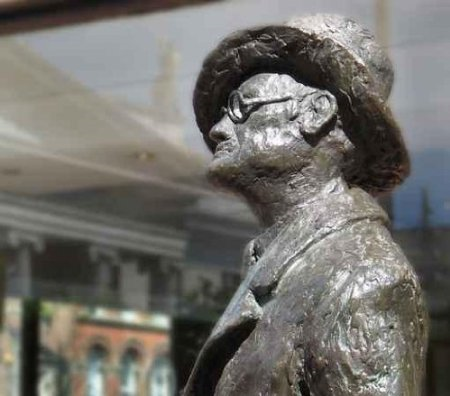 |
Shellfish was a big trade in Dublin. There was a poem about a woman called Molly Malone who sold 'cockles and mussels' for a living. There is a verse that says, in part:
"She died of a fever
and no one could save her
and that was the end of sweet Molly Malone".
Molly Malone probably died of contaminated shellfish. The cockle trade ended because of the highly polluted river, and after a while nothing could live in the Liffey. Because of this, a group of Dubliners started to clean up the river. Today, salmon and other fish swim upstream and are caught for eating. The River Liffey is clean again.
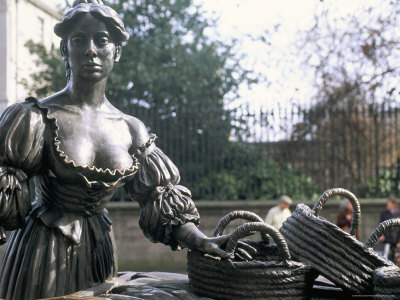 |
Disclaimer: LittleShamrocks.com is an affiliate website that receives commissions from sales of the products listed. We have purchased and sampled many, but not all, of the products on these pages.
© Copyright LittleShamrocks.com. All Rights Reserved.

